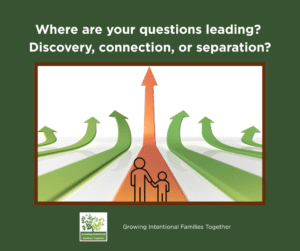
Every month this blog post takes a look into some of the points made during our recent vlog/podcast. Our featured guest this month was Dr. Sharon A McNamara, a licensed psychotherapist and an adoptee. She “believes that most children have some version of relational trauma as a result of being adopted. By accepting this as a starting place, the adoptive parents can understand better how an adopted or foster child may have different reactions to so-called “normal” parenting practices.”[1]
Dr. McNamara shared many valuable insights during our discussion including some “big” topics like Rejection Sensitivity, identity formation, and helping our children to launch successfully into adulthood. She asserts that understanding how these factors might be playing out in our children’s lives helps us to connect with and support our children better. Click to watch the full vlog and hear her complete conversation.
Even if we lacked any official terminology most of us have experienced how sensitive our children are to rejection, how easily they are triggered by anything that suggests they might be left out or left behind, and how they seem to struggle more with identity issues than children who are not adopted. So, we’ve accomplished the first step: noticing!
Step two would be noticing but a particular type of noticing, in the moment and with empathy. This sounds simple and straight forward. In reality it is anything but simple. When our kids are showing dysregulated behaviors, we frequently mirror their emotional intensity and respond with our own dysregulation. Unless…unless we are very intentional and aware of both our own emotional state and are committed to accomplishing our goal of staying regulated ourselves. This means engaging our regulation to help lower the emotional thermostat in the moment. We resist the temptation to meet fire with fire, anger with anger, frustration with frustration. To do this, we must use our informed, thinking brain, right? So, what helps us stay in that mindset?
One pivotal factor is recognizing the distinction between what our child can’t do versus what they won’t do. Dr. McNamara’s insights address this distinction. She reminds us of the impact of relational trauma caused by adoption and how this relational trauma complicates things. So, when we stay mindful of things like rejection sensitivity, discomfort with sudden change, identity struggles, and so on, it helps us stay in a curious mindset rather than a reactive mindset.
Great! What’s the next step?
Curiosity is Step 3. When we are curious, it follows that we want to gather answers, so, we start asking some questions. Since we are human, the ones that often come to mind quickly are:
- What were you thinking?
- Why on earth did you do that?
- Did you even stop to consider the consequences?
As you look back, in your own parenting history, how many times did you fall into this kind of questioning?
- How productive were such questions? How well did they reflect your understanding of the influence that trauma has on your child’s behavior?
- How did they help your child grow from the situation?
- How did they help to affirm your child’s confidence in making good choices or decisions?
The purpose of these questions is not to cause regret, guilt or shame. It is to highlight the potentially powerful effect our questions can have on the parent relationship and also on the child’s ability to experience growth or shame or better yet to avoid experiencing shame.
Identifying the “right questions
What might happen if we develop a consistent ability to pause and consider the questions we pose to our children and the effect that those questions have on their behavior? What might shift? Just like it is effective and encouraging to offer our children a “redo”, we too benefit from revisiting our behaviors and choices, reimagining different actions, choices and conversations and performing our own “redo’s” with our children. We can choose to perform our own redo with our child. Relationship repair can be both effective, instructional, and admittedly, humbling.
So, what kind of questions might be more fruitful? For some guidance, let’s consider the work of Dr. Larry Brendtro and Dr. Martin Brokenleg, authors of the book, Reclaiming Youth at Risk: Futures of Promise. They assert that we tend to ask three types of questions. After you read each question pause to consider what emotional state the question evokes.
- The Deficit Question What is wrong with you?
- The Trauma Question: What has happened to you?
- The Resilience Question: What is strong with you?
Implementing this approach
Now that you have sat with those questions and felt their respective weight, how will you change the questions you ask your child the next time you face a “situation”? How will you strive to make it a learning conversation that encourages them to improve the way they make choices and decisions?*
Before you launch into questions with your child, take time to calm yourselves. Strive to connect with them. Reassure them that the misstep can be handled. Of course, that does not mean you will fix it for them. Rather, it means you will help them identify how they can remedy the problem. Most importantly, allay any fears of rejection and abandonment that they might have. Assure them that even if you are disappointed, angry, or heartbroken about this circumstance, you are still family and their place in that family is assured.
Some growth mindset questions might be:
- What was your goal?
- What did you get right?
- What did you believe would happen?
- Who might you have asked to help you make the choice/decision?
- Who was best served by your choice/decision/actions?
- Who was supporting you in the moment?
These are only a few questions that you might consider. The more you practice ahead of time, the easier it will be to respond with intention in the moment.
The distinction between choice and decision
By the way, According to Forbes magazine. “Choice connects to the place of desired intention, values and beliefs. Decision connects to the place of behavior, performance and consequences. You might say that choices are connected to reasons and decisions are connected to causes.
Understanding the difference between the place of choice and the point of decision helps you practice identifying your feelings, whether positive or negative, so you can make inspired choices and clear, robust decisions. By visiting the place of choice first, you can obtain the confidence needed to stay motivated and take bold, life-changing actions.
By understanding the difference between choosing and deciding, you can avoid having regrets about what you have done or not done in life. Utilize your full human potential and be the best version of yourself. Understand and appreciate the difference between choosing and deciding.”[2]
Now I think that is a useful distinction. It might be helpful to share it with our kids.
[1] https://www.fosteradoptmn.org/therapist/sharon-stein-mcnamara-ed-d-lp/
[2] https://www.forbes.com/sites/forbescoachescouncil/2017/05/19/the-difference-between-making-a-choice-and-a-decision/ The Difference Between Making A Choice And A Decision, Forbes
__________________________
-
- Call us at 1-800-653-9445
- Listen to our podcasts: Adoption Matters: Real People. Real Life. Real Talk and Essentials of Adoption Attuned Parenting
- Watch our YouTube channel
- Read Books written by our coaches
- Click to learn more about Adoption Attuned Certified coaching!
- Check out our on-demand courses.


